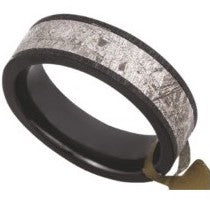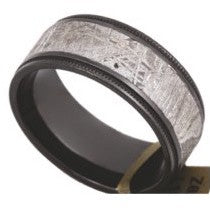Meteorite Ring Info
An Unstoppable Force

Consider two people, drawn together by an undeniable attraction. Yesterday they were strangers; today they are on a unique journey – a journey that will determine who they become together. As two worlds collide, love can happen in an instant. But, the foundation for a lifelong relationship takes much longer to solidify.
The lovers’ journey – from initial meeting to marriage and beyond – is an apt metaphor for the authentic Gibeon Meteorite used in our rings. This rare type of meteorite is composed of metals which were formed in a super-heated state and cooled over the course of 4 billion years.
This slow cooling, or solidification, settled the molecules in a crystalline structure, similar to what you’d see in a diamond or gemstone. Not only does this rare phenomenon not occur naturally on Earth, but it’s also what gives the metal its distinctive, patterned look and priceless meaning.
Wear a Meteorite ring and forever remember that what you and your loved one become over time is so much more than the attraction that initially brought you together.
Where Is It From?
Gibeon Meteorite was formed in space four billion years ago. It exploded upon entering Earth’s atmosphere, landing in the desert of Namibia, Africa in scattered pieces over an area 171 miles long and 62 miles wide.
The Namibian government banned the export of Gibeon Meteorite, as any newly discovered pieces are automatically protected as national monuments. This means that any meteorite specimens in circulation are of increasing value and incredibly limited supply.
The origin and rarity of each meteorite ring makes it a distinctive piece of art.
Unique Characteristics
Gibeon Meteorite features a distinct crystalline structure on its surface, a pattern found only in diamonds and gemstones. This visible crystal structure, or Widmanstätten pattern, was caused by extremely slow cooling of the material in space.
The Widmanstätten pattern will vary slightly between pieces, as will the presence of inclusions. Inclusions are dark spots or tiny holes on the surface of the meteorite that are often traces of metals that, in some cases, do not occur naturally on earth. These inclusions are an important clue to the meteorite’s origin and are identifiers of its authenticity.
Even though most Meteorite will not exhibit these inclusions, it is important that it not be rejected when it does. In some cases after a client understands the true nature of Meteorite, they request a piece that exhibits some of these characteristics. It helps them identify it as their own and it reinforces that it came from space and no two pieces are alike.
The acid etching of the Meteorite is the last step in the production of the ring. It is here where natural characteristics show themselves. Sometimes we can detect where one of these natural characteristics occurs, and avoid setting a diamond near it so the diamond’s appearance can stand alone.
Common Inclusions

This is a normal seam.

This inclusion exhibited itself after the diamond was set and the etching was complete. That means we can get all the way through the process and this can happen at the end, though it is quite rare.

This is about as large of a natural characteristic you would see and at the far end of what we would send. Ironically, we have stores whose clients understand the mystique of meteorite and actually request a slice of meteorite that exhibits this. There is nothing structurally unsound with the metal.

This is a good example of the fluctuations in pattern, texture, and coloring in meteorite.

This is another good example of the texture and coloring in meteorite. It also shows a straight seam.

This is another example of a natural occurring characteristic. It looks similar to how a water spot would darken an area. This is not common.

This is a great example of the Widmanstätten pattern. It also shows good variation in color and shadows.

This ring exhibits a common black spot found in meteorite. It also displays distinctive Widmanstätten lines varying in direction.

This exhibits a less common pattern and coloring found in meteorite.

This is another great example of a black spot found in meteorite.

The meteorite in this ring shows a rare area of many small black spots.
Benefits
- Limited supply
- Rare and exotic material
- As a natural material, each piece will be unique with no two rings being identical
- Made in space
Customization & Personalization
We produce styles incorporating Meteorite in contemporary metals, precious metals and combinations of the two. Meteorite can be inlaid in the center of a ring or off-center and in a round or square band.
Wear & Care
Despite its natural protection against rust, Gibeon meteorite is primarily composed of iron so oxidation is always a possibility. Exposure to strong oxidizing agents such as chlorine, bleach, or salt can increase the chance of rusting. These chemicals, found in strong household cleaners, pools, hot tubs, and salt water, should be avoided. We are continually embracing new research and technology. In May 2017, there was an evolution in the way we treat meteorite that will continue to minimize the possibility of rust. If rust does appear, it can easily be removed.
Cleaning
Meteorite can be cleaned with a mixture of baking soda and water by scrubbing it with a soft bristle toothbrush. Make sure it is dried thoroughly and dries overnight. Then put mineral oil on it to protect the meteorite.
FAQs
Will the Meteorite pattern fade?
Years of wear could eventually cause the pattern on the Meteorite to fade. We can re-etch the Meteorite, bringing the Widmanstätten lines back to their original look and feel.
What is the likelihood that the Meteorite will rust over time?
For most people, the meteorite should remain inert and rust-free during the course of normal wear. Daily wear will transfer your skin’s natural oils to help protect the meteorite. If rust does appear, it can be easily removed. We stand ready to provide details or take care of the ring anytime.
Why do Meteorite rings have seams?
Meteorite inlays start as flat strips of metal. They are then curved around the outside of the band, and joined together with a seam.
